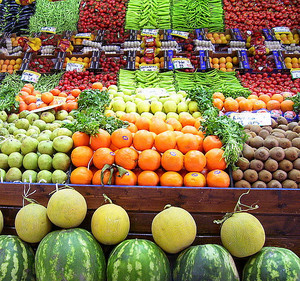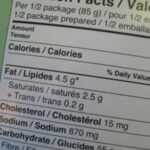The food pyramid was originally created by Francesca Morris, It is made up of six food groups. The healthier food groups begin at the bottom of the pyramid, which is larger. This signifies that you should eat more of the healthier foods. Less healthy foods can be found at the top of the food pyramid. These foods should be eaten sparingly. A list of the foods found in the food pyramid will help you make the right choices when grocery shopping.
Grains
The USDA recommends 6 to 11 servings from the grain group each day. The grain group mainly includes breads, cereals, rice and pasta. Oatmeal, Cream of Wheat, pancakes, french toast, muffins, granola bars, pretzels, whole-wheat crackers and whole wheat tortillas are also part of the grain group. When choosing your grains in the store, look for whole grains. Refined grains may be tasty, but during processing the iron, B vitamins and dietary fiber are removed.
Vegetables
Vegetables provide lots of vitamins and minerals, and should be consumed at a rate of three to five servings daily. Vegetables include broccoli, carrots, celery, squash, lettuce, lima beans, sweet potatoes, pumpkin, turnips, cauliflower, brussels sprouts and eggplant. Some foods you may not realize belong in the vegetable food group are spaghetti sauce, V-8 juice, vegetable soup and canned tomatoes.
Note: Vegetables can be raw, or cooked.
Fruits
About two to four servings per day of fruit is suggested. In addition to vitamins, fruits contain natural sugars and fibers. Foods in the fruit group include apples, oranges, nectarines, bananas, pears, peaches, grapes, strawberries, pineapples, blueberries, cherries, lemons, watermelons and cantaloupes. Some foods you may not expect to see belong to the fruit category include applesauce, 100% fruit juice and raisins. Fruits can be fresh, dried or canned.
Dairy
Dairy foods are foods that come from milk. Milk provides our bodies with calcium, phosphorus, vitamin A and vitamin D. You need to consume two to three servings from the dairy group each day. Dairy products include yogurt, ice cream, pudding, mozzarella, cheddar, American cheese, milk, evaporated milk, infant formula, cottage and ricotta cheese. Cream cheese, butter and cream seem like they should be good dairy choices, but they are not because they contain little to no calcium.
Meats-Proteins
Foods in the meat-protein category should be consumed at a rate of two to three servings daily. These foods include ground beef, chicken, pork chops, lamb, turkey, fish, steak, nuts, sunflower seeds, pumpkin seeds, dried beans, dried peas, liver, venison, eggs, anchovies, lobster, tuna and peanut butter. To reduce the amount of calories consumed in the meat-protein group, you will want to choose items that are labeled as lean, or low in fat.
Fats, Oils and Sweets
Foods in the fats, oils and sweets group are not recommended on a daily basis. They have little to no nutritional value, and should be used sparingly. Items in this food group include butter, vegetable oil, mayonnaise, salad dressing, sugar, shortening, soybean oil, margarine, canola oil, lard, jelly, syrup, corn oil and candy bars.
References:
United States Department of Agriculture: Food Groups
University of Maine Cooperative Extension: Food for Me




